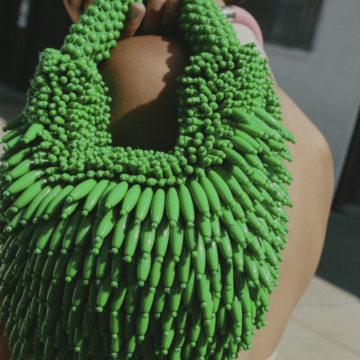

Clean Jeans, Baby: How To Care For Your Denim
A pair of crisp, clean jeans is a tabula rasa. Jeans allow for endless outfit combinations and effortless day-to-night transformations. They are arguably the perfect WFH pants to make up for months of sartorial surrender (we’re looking at you, sweats). And, at the end of the day, they’re just plain classic.
Denim has a dirty little secret though — it wreaks havoc on the environment. According to UN Climate Change, it takes approximately 10,000 liters of water to produce the cotton for a single pair of jeans, and that doesn’t account for the amount of water used for dyeing and finishing them. What’s more, the wastewater from these processes pollutes rivers, oceans and ecosystems. Greenhouse gas emissions are also at play; producing a pair of jeans is equivalent to driving a car over 80 miles, the World Resources Institute reports.
While some innovative companies are paving the way for a more environmentally friendly textile industry in the future, immediate change can start at home. Caring for your jeans properly will extend their life, and consigning (instead of tossing) will keep them in the circular economy and out of a landfill. Selling a pair of clean jeans also has a measurable impact; since The RealReal’s founding, consignors have saved 106 million liters of water and 535 metric tons of carbon by re-selling their jeans (you can track your own fashion footprint here).
If you’re ready to adopt a more sustainable approach to caring for your jeans, The RealReal’s Associate Fashion Valuation Manager Christopher Chavez is here to help you out. Whether you’re seeking a step-by-step guide to clean jeans, looking for tips on refreshing your denim between washes or merely wondering if that “jeans-in-the-freezer” myth is for real, Chavez has the answers. Read on to keep your jeans fresh — and, when you’re ready to consign, in top resale condition.
Clean Jeans: Does The Freezer Really Work?
If you’re a die-hard denim aficionado, or perhaps just a purveyor of unconventional cleaning hacks, you’ve likely heard of the freezer trick: stick your jeans in the freezer as an alternative to washing them. “Some enthusiasts stand behind the concept of freezing your jeans,” says Chavez. “The belief is that the cold will kill the bacteria on your jeans, and remove the odor that it causes. While this is a great quick fix, the cold air only stunts the growth, and doesn’t address other factors that can cause odor like dead skin, sweat and dirt build-up.”
Chavez’s personal recommendation is to treat your jeans with heat instead of ice. “To get to the root cause, my suggestion would be to dry out the bacteria with heat,” he notes. “This is a great way to refresh your jeans between washes. Hang your jeans inside-out in a warm, dry area — like by the window on a sunny day — after spot-cleaning dirt and stains. After a day, you can return them to the closet.”
Clean Jeans: A Step-By-Step Guide

#TRRTip: You could save 279 liters of water and 1.31 kilograms of carbon by consigning RE/DONE, Off-White or Vetements jeans.
Before you drag your denim jeans, jackets and shirts out of the icebox and prepare for a wash-a-thon, take the time to assess the state of each item. “You should only launder your jeans whenever they are in need of a really deep clean,” says Chavez. “The dyes in denim are very delicate by design, and the pigment is meant to be rubbed off over time to give it that desirable ‘lived-in’ look. This means that the abrasion in the washing machine can drastically alter their appearance. Washing and drying your cotton too often will strip the fibers of their pigment, and lead the denim to thin. How often you wash your jeans will depend on how often you wear them. It’s best to wash between five to seven wears, or when you’re battling stains that defy spot-cleaning, but this can vary based on use.” This could also mean weeks or months between washes, but it will help extend your denim’s lifespan.
How To Spot-Clean Denim
“Spot cleaning is the most effective way to help keep your denim fresher longer,” says Chavez. Luckily, the most sustainable solutions may already be in your cupboards. “One of the most effective natural products to use when cleaning denim is household vinegar, but you can also substitute vinegar for vodka and rubbing alcohol. They’re all effective liquids for lifting odors and breaking up surface stains. First, put distilled white vinegar and water (one part vinegar to four parts water), vodka or rubbing alcohol in a spray bottle. Place a towel beneath the article of clothing to absorb excess moisture, then dampen the spot or stain with cold water using a microfiber cloth. Spray the stain with your solution and work it in with the cloth. You can also use a toothbrush to break up deeper stains if needed. And if the jeans are an overdyed indigo or made of raw denim, make sure to turn them inside out before cleaning.”

#TRRTip: You could save up to 400 liters of water and up to 1.89 kilograms of carbon by consigning a Gabriela Hearst, Dior or Stella McCartney denim jacket.
How To Wash Denim
When it’s finally time for a wash, you have two options — washing by hand and washing by machine. Hand-washing with cold water can conserve both water and the energy used to heat the water. “Fill your tub with cold or lukewarm water and either ¼ cup of vinegar or a few drops of a gentle, natural detergent,” says Chavez. “Turn the denim inside out, and then lay it flat in the water for 30-45 minutes. Avoid scrubbing or disrupting the water while the jeans soak. Finish by rinsing quickly under cold water, and then you’re done!”
If you choose to wash your denim in a machine, first zip all the zippers, button all the buttons and turn the item inside out. “Zippers and buttons can snag in the wash,” notes Chavez. “Once your pieces are ready, set the machine to the delicate or light load setting and use cold water only. You can use a natural detergent and fabric softener, but it’s not necessary.”
How To Dry Denim
Drying your denim is the most sustainable aspect of caring for your jeans, as it requires nothing but time. “Dry denim pieces on a clothesline, where the denim can be fully opened up and exposed to the air,” says Chavez. “Always hang-dry to avoid shrinkage, and make sure to keep your garments out of direct sunlight.”
If you need your denim dried ASAP, you can turn to the dryer, but proceed with caution. “In a pinch, you can put your denim in the dryer, using the lowest heat setting for a short amount of time,” says Chavez. “For jeans made with spandex and lycra, the only difference in laundering is in the drying. Heat can cause elastic to become brittle and frail. Avoid putting jeans that incorporate spandex and lycra in the dryer, as the elastic will eventually lose its stretch.”
Forgot to set a timer and ended up with denim two sizes too small? It happens to the best of us. “In case of shrinkage, the best way to ‘grow’ your jeans is to reintroduce them to moisture,” says Chavez. “Spray your denim down with some lukewarm water until damp. Put it down on a protected surface, since the dyes can sometimes leak through, and carefully stretch in the areas needed. Lay flat to dry, and the garment should relax a bit.”

#TRRTip: You could save 322 liters of water and 1.52 kilograms of carbon by consigning a Louis Vuitton, The Elder Statesman or Tom Ford denim jacket.
How To Store Denim
Once your denim is clean and dry, make room in the closet — not the dresser drawers — for your pieces. “Folding can leave permanent marks on your garments,” says Chavez. “Make sure your denim is as flat as possible, separating your raw and lighter-wash denim in the closet to avoid color transfer. Hanging up jackets and shirts is key. It also ensures that your denim can breathe and won’t hold onto any odors. Avoid clipped hangers for jeans and opt for hangers with a pant bar. Clips can leave indentations. Plus, using a pant bar will prevent hard creases from harming your jeans. And, again, make sure your pieces aren’t stored in direct sunlight.” Bonus tip: if you’re low on closet space, you can store your jeans by folding them in thirds and keeping them in a dark, cool area.
Clean Jeans: Wear, Care, Sell

#TRRTip: You could save 357 liters of water and 1.68 kilograms of carbon by consigning Raf Simons x Sterling Ruby, Fear Of God or Gucci jeans.
Caring for your denim sustainably doesn’t just extend its lifetime in your wardrobe. Regular care also helps give denim a second wind when you’re ready to consign. “When it comes to men’s denim, pieces in pristine condition — with tags, no signs of wear — are priced on TRR 15% higher than items in any other condition, on average,” says Senior Men’s Merchandising Manager Aaron McWilliams. Don’t let that dissuade you from selling denim without tags, though. “Worn-in denim is great to consign. Jeans in pristine, excellent, very good and good condition all sell at about the same rate, which really speaks to the versatility and lasting qualities of denim.”
Women’s denim is also highly coveted in the secondary market. “Pristine women’s denim, from jeans to jackets, sells 60% faster than all other conditions combined,” notes Associate Merchandising Manager Hayley Purse. “Denim in excellent condition — without tags, no signs of wear — sells 50% faster than jeans in very good and good condition combined, and is also priced 25% higher. The big takeaway here: the better the condition, the better the sell-through and resale value.”




